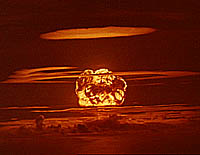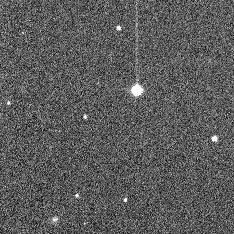|
Ivan's Hammer
Ivan's Hammer is the idea to use a natural asteroid or meteoroid as a weapon of mass destruction in a first-strike role. The concept can be traced back to the 1960s. At the annual meeting of the American Astronautical Society, in January, 1962 Dandridge M. Cole warned that as early as 1970 the Soviets could develop the technology to divert a near earth asteroid to impact a target on earth. A RAND Corporation study from 2002 also discusses the method and feasibility of such an application. The American astronomer Carl Sagan warned about the possibility of asteroid deflection technology being used as a weapon in several works, describing a "deflection dilemma" for projects seeking to address the asteroid impact hazard."Pale Blue Dot". Sagan, Carl. Headline Book Publishing 1995. See also *Directed-energy weapon *Laser weapon *Space weapon *Kinetic bombardment *Prompt Global Strike Conventional Prompt Strike (CPS), formerly called Prompt Global Strike (PGS), is a United States ... [...More Info...] [...Related Items...] OR: [Wikipedia] [Google] [Baidu] |
Asteroid
An asteroid is a minor planet—an object larger than a meteoroid that is neither a planet nor an identified comet—that orbits within the Solar System#Inner Solar System, inner Solar System or is co-orbital with Jupiter (Trojan asteroids). Asteroids are rocky, metallic, or icy bodies with no atmosphere, and are broadly classified into C-type asteroid, C-type (carbonaceous), M-type asteroid, M-type (metallic), or S-type asteroid, S-type (silicaceous). The size and shape of asteroids vary significantly, ranging from small rubble piles under a kilometer across to Ceres (dwarf planet), Ceres, a dwarf planet almost 1000 km in diameter. A body is classified as a comet, not an asteroid, if it shows a coma (tail) when warmed by solar radiation, although recent observations suggest a continuum between these types of bodies. Of the roughly one million known asteroids, the greatest number are located between the orbits of Mars and Jupiter, approximately 2 to 4 astronomical unit, AU ... [...More Info...] [...Related Items...] OR: [Wikipedia] [Google] [Baidu] |
Meteoroid
A meteoroid ( ) is a small rocky or metallic body in outer space. Meteoroids are distinguished as objects significantly smaller than ''asteroids'', ranging in size from grains to objects up to wide. Objects smaller than meteoroids are classified as ''micrometeoroids'' or ''space dust''. Many are fragments from comets or asteroids, whereas others are impact event, collision impact space debris, debris ejected from bodies such as the Moon or Mars. The visible passage of a meteoroid, comet, or asteroid atmospheric entry, entering Earth's atmosphere is called a meteor, and a series of many meteors appearing seconds or minutes apart and appearing to originate from the same fixed point in the sky is called a meteor shower. An estimated 25 million meteoroids, micrometeoroids and other space debris enter Earth's atmosphere each day, which results in an estimated 15,000 tonnes of that material entering the atmosphere each year. A ''meteorite'' is the remains of a meteoroid that has surv ... [...More Info...] [...Related Items...] OR: [Wikipedia] [Google] [Baidu] |
Weapon Of Mass Destruction
A weapon of mass destruction (WMD) is a biological, chemical, radiological, nuclear, or any other weapon that can kill or significantly harm many people or cause great damage to artificial structures (e.g., buildings), natural structures (e.g., mountains), or the biosphere. The scope and usage of the term has evolved and been disputed, often signifying more politically than technically. Originally coined in reference to aerial bombing with chemical explosives during World War II, it has later come to refer to large-scale weaponry of warfare-related technologies, such as biological, chemical, radiological, or nuclear warfare. Early usage The first use of the term "weapon of mass destruction" on record is by Cosmo Gordon Lang, Archbishop of Canterbury, in 1937 in reference to the bombing of Guernica, Spain: At the time, nuclear weapons had not been developed fully. Japan conducted research on biological weapons, and chemical weapons had seen wide battlefield use ... [...More Info...] [...Related Items...] OR: [Wikipedia] [Google] [Baidu] |
First-strike
In nuclear strategy, a first strike or preemptive strike is a preemptive surprise attack employing overwhelming force. First strike capability is a country's ability to defeat another nuclear power by destroying its arsenal to the point where the attacking country can survive the weakened retaliation while the opposing side is left unable to continue war. The preferred methodology is to attack the opponent's strategic nuclear weapon facilities (missile silos, submarine bases, bomber airfields), command and control sites, and storage depots first. The strategy is called counterforce. Historical background ''First-strike attack'', the use of a nuclear first strike capability, was greatly feared during the Cold War between NATO and the Soviet Bloc. At various points, fear of a first strike attack existed on both sides. Misunderstood changes in posture and well understood changes in technology used by either side often led to speculation regarding the enemy's intentions. 1948 ... [...More Info...] [...Related Items...] OR: [Wikipedia] [Google] [Baidu] |
Dandridge MacFarlan Cole
Dandridge MacFarlan Cole (February 19, 1921 – October 29, 1965) was an American aerospace engineer, futurist, lecturer, and author. Biography Parents, education, and military service Cole was born February 19, 1921 in Sandusky, Ohio to Robert MacFarlan Cole III and Wertha Pendleton Cole, the daughter of bishop William Frederic Pendleton. In 1928 the family moved to Bryn Athyn, Pennsylvania, where his mother had been raised. He spent the balance of his childhood there, residing elsewhere only during his college and wartime years. He attended the Academy of the New Church Secondary Schools from 1935 to 1939 and entered Princeton University in the fall of 1939. In his application to Princeton, he mentions, as one of the things attracting him to the University, what Henry Norris Russell, then director or the Princeton Observatory, had written about interplanetary travel. While at Princeton, he reported in a letter home, he did student work for Albert Einstein. In addition to h ... [...More Info...] [...Related Items...] OR: [Wikipedia] [Google] [Baidu] |
RAND Corporation
The RAND Corporation, doing business as RAND, is an American nonprofit global policy think tank, research institute, and public sector consulting firm. RAND engages in research and development (R&D) in several fields and industries. Since the 1950s, RAND research has helped inform United States policy decisions on a wide variety of issues, including the Cold War space race, the U.S. involvement in the Vietnam War, the U.S.–Soviet nuclear arms confrontation, the creation of the Great Society social welfare programs, and national health care. RAND originated as "Project RAND" (from the phrase "research and development") in the post-war period immediately after World War II. The U.S. Army Air Forces established Project RAND with the objective of investigating long-range planning of future weapons. Douglas Aircraft Company was granted a contract to research intercontinental warfare. Project RAND later evolved into RAND, and expanded its research into civilian fields suc ... [...More Info...] [...Related Items...] OR: [Wikipedia] [Google] [Baidu] |
Carl Sagan
Carl Edward Sagan (; ; November 9, 1934December 20, 1996) was an American astronomer, planetary scientist and science communicator. His best known scientific contribution is his research on the possibility of extraterrestrial life, including experimental demonstration of the production of amino acids from basic chemicals by exposure to light. He assembled the first physical messages sent into space, the Pioneer plaque and the Voyager Golden Record, which were universal messages that could potentially be understood by any Extraterrestrial life, extraterrestrial intelligence that might find them. He argued in favor of the hypothesis, which has since been accepted, that the high surface temperatures of Venus are the result of the greenhouse effect.Extract of page 14 Initially an assistant professor at Harvard Universi ... [...More Info...] [...Related Items...] OR: [Wikipedia] [Google] [Baidu] |
Asteroid Impact Avoidance
Asteroid impact avoidance encompasses the methods by which near-Earth objects (NEO) on a potential collision course with Earth could be diverted, preventing destructive impact events. An impact by a sufficiently large asteroid or other NEOs would cause, depending on its impact location, massive tsunamis or multiple firestorms, and an impact winter caused by the sunlight-blocking effect of large quantities of pulverized rock dust and other debris placed into the stratosphere. A collision 66 million years ago between the Earth and an object approximately wide is thought to have produced the Chicxulub crater and triggered the Cretaceous–Paleogene extinction event that is understood by the scientific community to have caused the extinction of all non-avian dinosaurs. While the chances of a major collision are low in the near term, it is a near-Law of large numbers, certainty that one will happen eventually unless defensive measures are taken. Astronomical events—such as the C ... [...More Info...] [...Related Items...] OR: [Wikipedia] [Google] [Baidu] |
Pale Blue Dot (book)
''Pale Blue Dot: A Vision of the Human Future in Space'' is a 1994 book by the astronomer Carl Sagan. It is the sequel to Sagan's 1980 book ''Cosmos'' and was inspired by the famous 1990 '' Pale Blue Dot'' photograph, for which Sagan provides a poignant description. In the book, Sagan mixes philosophy about the human place in the universe with a description of the current knowledge about the Solar System. He also details a human vision for the future. In 2023, the audiobook of ''Pale Blue Dot'', read by Sagan, was selected by the Library of Congress for preservation in the United States National Recording Registry as being "culturally, historically, or aesthetically significant." Summary The first part of the book examines the claims made throughout history that Earth and the human species are unique. Sagan proposes two reasons for the persistence of the idea of a geocentric, or Earth-centered universe: human pride in our existence, and the threat of torturing those who disse ... [...More Info...] [...Related Items...] OR: [Wikipedia] [Google] [Baidu] |
Directed-energy Weapon
A directed-energy weapon (DEW) is a ranged weapon that damages its target with highly focused energy without a solid projectile, including lasers, microwaves, particle beams, and sound beams. Potential applications of this technology include weapons that target personnel, missiles, vehicles, and optical devices."Daily Telegraph, 12th September 2013" ''Golden Eye-style energy beam is developed by Nato scientists'', Oct. 08, 2013"Milsat Magazine, Satnews Daily, June 24th 2009" ''U.S. Navy Laser Versus UAVs... Laser Wins...'', Oct. 08, 2013 I ... [...More Info...] [...Related Items...] OR: [Wikipedia] [Google] [Baidu] |
Laser Weapon
A laser weapon is a type of directed-energy weapon that uses lasers to inflict damage. Whether they will be deployed as practical, high-performance military weapons remains to be seen. One of the major issues with laser weapons is atmospheric thermal blooming, which is still largely unsolved. This issue is exacerbated when there is fog, smoke, dust, rain, snow, smog, foam, or purposely dispersed obscurant chemicals present. In essence, a laser generates a beam of light that requires clear air or a vacuum to operate. Many types of laser have been identified as having the potential to be used as incapacitating non-lethal weapons. They can cause temporary or permanent vision loss when directed at the eyes. The extent, nature, and duration of visual impairment resulting from exposure to laser light depend on various factors, such as the laser's power, wavelength(s), collimation of the beam, orientation of the beam, and duration of exposure. Even lasers with a power output of less ... [...More Info...] [...Related Items...] OR: [Wikipedia] [Google] [Baidu] |
Space Weapon
Space weapons are weapons used in space warfare. They include weapons that can attack space systems in orbit (for example, anti-satellite weapons), attack targets on the earth from space or disable missiles travelling through space. In the course of the militarisation of space, such weapons were developed mainly by the contesting superpowers during the Cold War, and some remain under development today. Space weapons are also a central theme in military science fiction and sci-fi video games. Space-to-space weapons The Soviet Almaz secret military space station program was equipped with a fixed 23mm autocannon to prevent hostile interception or boarding by hostile forces. This was the first and so far the only space-to-space weapon to be fired in orbit. The Soviet uncrewed Polyus weapons platform was designed to be equipped with a megawatt carbon-dioxide laser and a self-defense cannon. Earth-to-space weapons Anti-satellite weapons, which are primarily surface-to-space ... [...More Info...] [...Related Items...] OR: [Wikipedia] [Google] [Baidu] |







